Being in a particular posture for a long time can cause all sorts of musculoskeletal problems. Unfortunately, you have to be part of this office culture that involves excessive sitting hours, and this stress and bad posture can affect you physically, mentally, socially, and emotionally. You may also develop shoulder, neck, or cervical problems. Attrition and abrasion of spine desk may lead to cervical spondylosis. Luckily, you can prevent all these issues simply by doing yoga. Just by practicing a few simple poses, you can keep shoulder, neck, and cervical problems at bay.
Yoga for Cervical Spondylosis
1. Surya Namaskar
Also called Sun Salutation, you should try it if you are struggling with shoulder, neck, or cervical pain. By doing it properly, you will be able to add strength and flexibility to your spine that helps improve cervical spondylosis.
You have to do several backward and forward bending movements while stretching and flexing your spinal column. Watch the video below to help you understand the right way to do this yoga pose.
2. Matsyasana
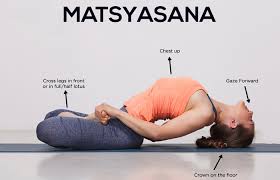
Try this pose if you are interested in yoga for spondylosis because it improves flexibility and strength of the entire vertebral column. It works great for cervical region and eliminates stress caused by prolonged sitting.
Get in padmasana and relax. By supporting your body with your elbows and arms, start bending backward until your chest is toward the ceiling. Be sure to inhale while bending backward and creating an arched back. Let your neck and head to relax by dropping the crown of your head on the ground. Ensure that the entire weight of your body is on your elbows and arms, not on your head.
3. Bhujangasana
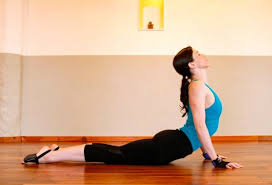
Any stiffness of the spine can cause various ailments because your spine carries nerve impulses from the brain to the rest of your body. The yoga pose is extremely good for your shoulders and neck and is a great remedy for cervical problems.
Lie down on your stomach with your palms next to your chest. Raise your ribcage and chest off the floor without moving the rest of your body. Ensure that your elbows are bent and properly tucked into your waist. Exhale slowly while returning to the starting position.
4. Makarasana
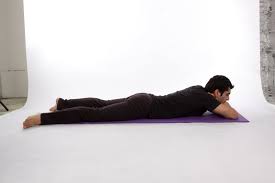
Makarasana is one effective yoga for cervical spondylosis. The yoga pose works great to bring your spine in its normal shape. It also helps release any compression of the nerves, which in turn helps treat cervical spondylosis.
Lie down on your stomach and join your elbows together to make a stand. Keep your palms under your chin and slowly lift your chest up. Now, keep your legs and elbows together and inhale. While inhaling, fold your one leg first and then the other one. Ensure that your ankles touch your hips. Exhale slowly while keeping your feet straight and head steady. Repeat 20-25 times.
5. Bal-Shayanasana
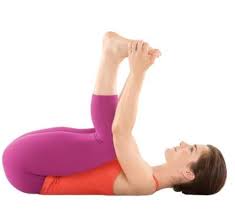
The asana is beneficial for anyone suffering from cervical spondylosis or lower back pain caused by tension, stress, and excessive workload.
Start by lying on your back. Exhale gently and start bending your knees into your stomach. Inhale and use your hands to grab the outsides of your feet. Now, slowly open your knees until they are wider than your torso and then lift them up toward your armpits. Ensure that each ankle is over the knee with shins completely perpendicular to the ground. While flexing through your heels, push your feet into your hands. Try to pull your hands down at the same time to create a resistance.
6. Ardha Naukasana
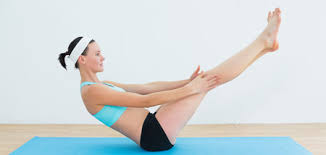
Yoga for cervical spondylosis should include Ardha naukasana because it relieves back and cervical pain quite effectively. It also helps manage constipation and chronic indigestion.
In prone position, bend your left arm and gently place it behind your back palm. Slowly stretch your right arm above your head and breathe out. Inhale slowly and raise your right hand, chest, head, and right leg above the floor. Maintain the position and continue to breathe normally. Inhale again and lower your shoulder, right arm, forehead, and leg while breathing out. Take your hands to the sides of your body with your chin placed gently on the ground. Return to the starting position.
7. Ardha Salbhaasana
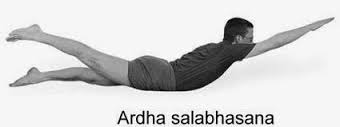
The pose helps you relieve lumbargo, cervical pain, and sciatica. It proves effective for cervical spondylosis when practiced regularly.
Lie down on your stomach and keep your legs close together with hands on your sides. Ensure that your chest, abdomen, and chin are touching the floor. Clench your fists and inhale. Hold your breath. With your fists facing upwards, raise your left leg backwards, and ensure that your knee is straight. Keep the leg in the same position for five seconds while keeping your right leg steady. Breathe out and bring your left leg to the starting position. Exhale completely and repeat the same with your other leg.
8. Shanshank-Bhujangasana
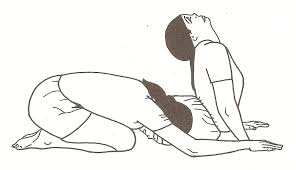
It adds strength and flexibility to your spine to eliminate the effects of an inactive lifestyle. It helps treat your backache and cervical pain.
Get in sharnagat mudra first and do not move your hands. Lift your buttocks from floor and move forward. Bring your chest close to the floor while arching your back by extending the elbows. Lift your chin and open your chest. Maintain this position for a few seconds and then slowly return to the starting position.
9. Kohni Chalana
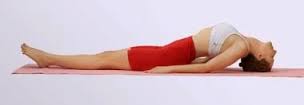
The asana helps improve the strength and mobility of your neck and shoulders. It is beneficial for anyone struggling with frozen shoulder, cervical spondylosis, and bursitis.
Keep your arm close to your body and create a 90-degree angle with your elbow. Slowly, rotate your elbow joint in both directions: clockwise and anticlockwise. If possible, try to rotate both elbows simultaneously.
10. Marjariasana
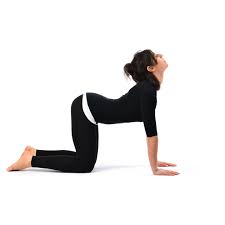
When it comes to yoga for cervical spondylosis, the marjariasana should be mentioned. The asana helps massage your spine to improve its flexibility. You may want to include it into your routine if you have chronic neck pain and rigid spine.
Get in a tabletop position while making sure your elbows, wrists, and shoulders are in line to the floor and your knees are right below your hips. Keep your head in a neutral position and eyes at the ground. Exhale slowly and round your spine upward toward the ceiling. Always keep your knees and shoulders in position. Without forcing your chin to your chest, slowly release your head downward. Inhale slowly while returning to the starting position.
